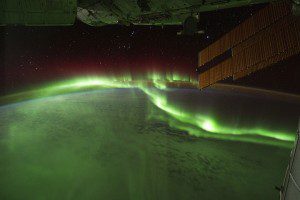
Click image to enlarge.
And the skies of night were alive with light, with a throbbing, thrilling flame; Amber and rose and violet, opal and gold it came. It swept the sky like a giant scythe, it quivered back to a wedge; Argently bright, it cleft the night with a wavy golden edge.
” An excerpt from “The Ballad of Northern Lights” by poet Robert Service
In describing auroras as he saw them in the far north in 1908, Service captured the sense of fluid motion; the vivid color; and the fiery, flame-like qualities one sees from the ground. His description works just as well in the southern hemisphere and when looking down from above, as shown in this image captured Sept. 17 from the International Space Station. Auroras are a spectacular sign that our planet is electrically and magnetically connected to the sun. These light shows are provoked by energy from the sun and fueled by electrically charged particles trapped in Earth's magnetic field.
The pressure and magnetic energy of the solar plasma stretches and twists the magnetic field of Earth like rubber bands, particularly in the tail on the night side. This energizes the particles trapped in our magnetic field; that energy is released suddenly as the field lines snap the particles down the field lines toward the north and south magnetic poles.
Fast-moving electrons collide with Earth's upper atmosphere, transferring their energy to oxygen and nitrogen molecules and making them chemically “excited.” As the gases return to their normal state, they emit photons”small bursts of energy in the form of light. The color of light reflects the type of molecules releasing it; oxygen molecules and atoms tend to glow green, white or red, while nitrogen tends to be blue or purple. This ghostly light originates at altitudes of 100 to 400 kilometers (60 to 250 miles).
Image courtesy of the ISS Crew Earth Observations experiment and Image Science & Analysis Laboratory, Johnson Space Center.
Caption by Michael Carlowicz.


